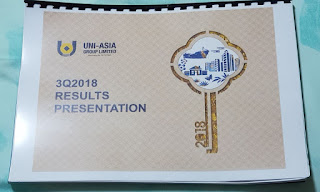Uni-Asia Group released its
results on Thursday 8 November. On initial glance, results definitely isn't good as it has been a loss making quarter. After emailing the investor relations and taking some time with my thinking cap, the below are my thoughts.
The Negatives
-Fair value losses of US$3.5 million for Containerships. Under Uni-Asia's books they have 4 containerships while 3 of them are subjected to fair value losses. From my research, as of 5 November, it seems like containerships have appreciated in value by 5%. Nevertheless i would have to continue tracking my research and see if it turns out as panned.
- 3Q had lesser operating days for Uni-Asia dry bulks. In 3Q 2018, the number of operating days was
736 days. Compared to 3Q 2017 which had 762 days, this is a shortfall of 3.4% of 26 days. If we were to use its charter income as a reference, this would bring about 265 000 to its income.
Which would partially explain why its charter income(7.515 million) has failed to outperform 3Q 2017(7.738 million).
The other half of the explanation would be that there were only 8 Ships on the books in 3Q 2018
compared to 3Q 2017 where there were 9 Ships and therefore would generate higher income.
The Positives
-Increased average daily charter hire rates
Average Charter hire rate per day in 3Q has broken the
10,000 usd mark. As of 1H 2018 it was
9875 USD per day and in 9M 2018 it was
9984 USD per day. After some simple calculations it amounted to
10202 USD per day in 3Q 2018. I would say this is pretty in line with my research as seen below.

- Containership fair value loss of $3.5 million highly unlikely to happen again
From my understanding after emailing the investor relations, the current fair value of the 3 containerships stood at $3.3 million. As such, unless there have been further purchases of containerships, it is unlikely to see another $3.5 million loss again
To add on, the fair value are assessed by discounted cash flow technique with 'daily charter rates' being a component in deciding the fair value.
As such with each year being closer to the end of useful life for a ship, it is 'normal' that the ships will continue to suffer fair value losses as the present value reduces with lesser cash flow in future as each year progresses
Interestingly Q4 2017 , Q3 2017, Q1 2018, Q2 2018 all had containership fair valuation loss as well
-2nd HK Project gains not fully recognized
With $29.4 million received from its 2nd Hong Kong Property, it has said in its financial statements that the gains are only
partial. Which means that there would likely be some more gains which is already very amazing considering the initial investment amount of around $10.4 million.

-Japan Property and Hotel making growth
Hotel Segments result has improved if pre-opening expenses are not accounted for.
The occupancy rate has improved year on year (from 81.3% to 82.8%) as well as quarter on quarter (from 77.4% to 82.8%). This is more impressive when accounting that more hotels are under operated this quarter(16) compared to previous year(11) and previous quarter(14).
Generally i would expect new hotels to reduce the occupancy rates instead
Revenue has also hit 20 million in the 3rd quarter, it was only 15.3 million in 2Q and 13.4 million in 1Q.
With only 1 hotel opening in 2019, I would expect pre-opening expenses to decline and we could see improvement in bottom line.
With regards to the ALERO projects, 2 completed projects has been sold and there is an additional project under lease. While lease projects might become sold overtime, a positive would be more projects under lease(could contribute rental income) and a project slated to complete in Jan 2019 has been sold.
The Obvious
-Largely Balance Sheet improvements.
Total borrowings reduced from 202.627 million to 186.596 million quarter on quarter (qoq)
Cash on hand increased from 38.861 million to 49.478 million qoq
Current ratio decreased from 1.283 to 1.196 qoq
Liabilities to Asset decreased from 0.607 to 0.597 qoq
Finance Cost(Interest Expense) decreased from 1.531 million to 1.46 million
-Cash flow improvements
Operating cash flow before change in working capital as well as net cash flow generated from operating activities are both positives in 3Q
Conclusion
The results are definitely not as terrible as it seems on first glance. With more gains from its property projects to be delivered, i do remain positive on the company.
Furthermore there are more pipelines for its Hong Kong properties underway as well.
However with 59.3% of its assets in maritime investments, there are definite opportunities for impairment losses and fair value losses to continue to occur if market sentiments are bad.
Having said that, it currently still trades at 0.31 book value.
While i have not done the math but it seems to indicate that the maritime assets are assumed to be of no value as 30.7% of net assets would amount to $1.58.
It is also worth noting that it is holding 1.05 usd per share of cash(as of 9 November it would be 1.45 sgd per share) compared to the trading price of 1.25 sgd
Note to Self
-An important lesson i learnt this time round will be to be more attentive in assessing how fair value are assessed (especially for the vessels that are under fair value through profit and loss). This was something that slipped off in my analysis in previous quarter's review.
- My self estimate of the assets left on that book as of 30 Sept 2018 would be roughly 11.6 million or 24.8 cents of its assets.
